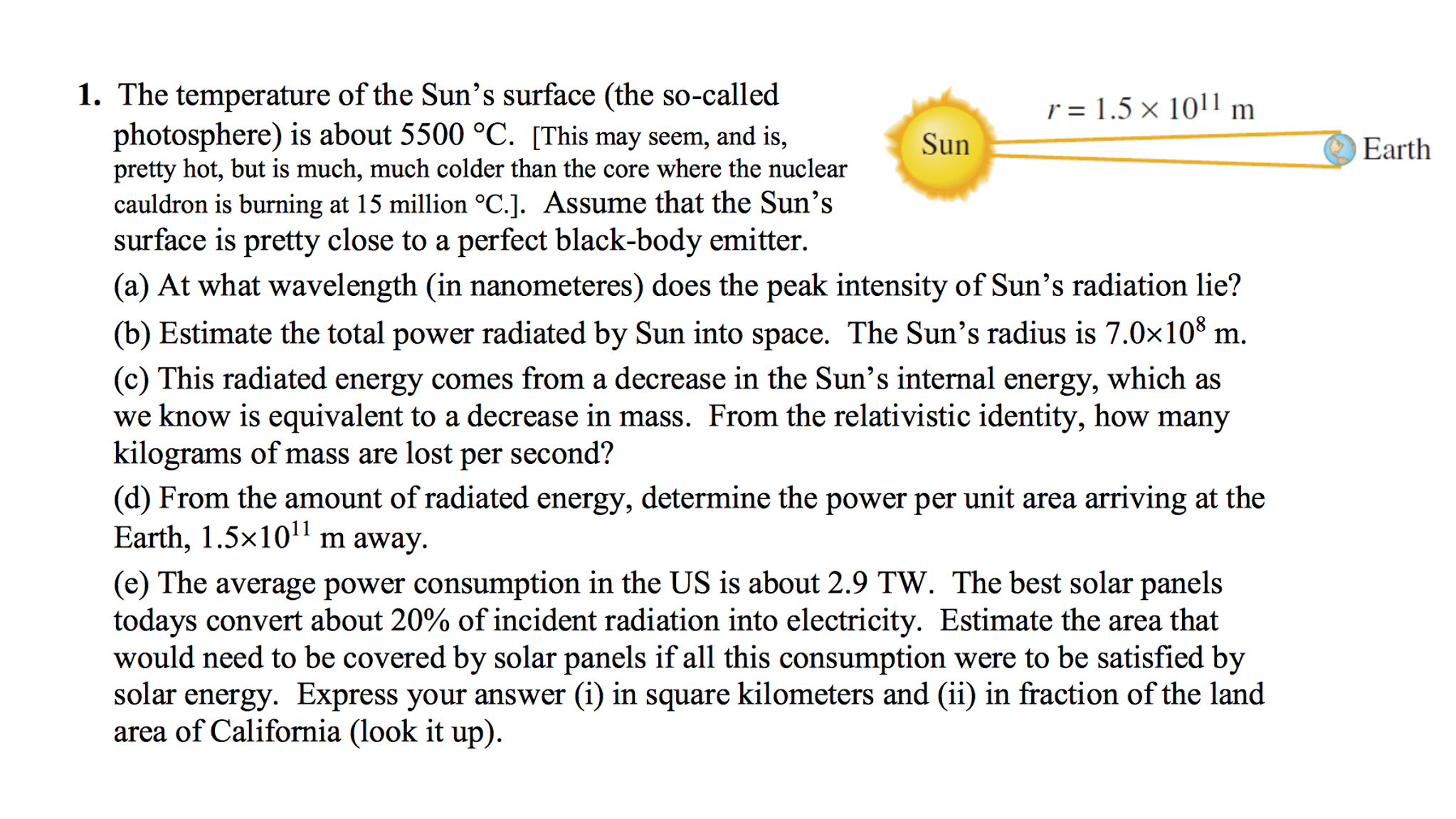Answered step by step
Verified Expert Solution
Question
1 Approved Answer
1. The temperature of the Sun's surface (the so-called photosphere) is about 5500 C. [This may seem, and is, pretty hot, but is much,

1. The temperature of the Sun's surface (the so-called photosphere) is about 5500 C. [This may seem, and is, pretty hot, but is much, much colder than the core where the nuclear cauldron is burning at 15 million C.]. Assume that the Sun's surface is pretty close to a perfect black-body emitter. Sun r = 1.5 x 1011 m (a) At what wavelength (in nanometeres) does the peak intensity of Sun's radiation lie? (b) Estimate the total power radiated by Sun into space. The Sun's radius is 7.0108 m. (c) This radiated energy comes from a decrease in the Sun's internal energy, which as we know is equivalent to a decrease in mass. From the relativistic identity, how many kilograms of mass are lost per second? (d) From the amount of radiated energy, determine the power per unit area arriving at the Earth, 1.5101 m away. (e) The average power consumption in the US is about 2.9 TW. The best solar panels todays convert about 20% of incident radiation into electricity. Estimate the area that would need to be covered by solar panels if all this consumption were to be satisfied by solar energy. Express your answer (i) in square kilometers and (ii) in fraction of the land area of California (look it up). Earth 1. The temperature of the Sun's surface (the so-called photosphere) is about 5500 C. [This may seem, and is, pretty hot, but is much, much colder than the core where the nuclear cauldron is burning at 15 million C.]. Assume that the Sun's surface is pretty close to a perfect black-body emitter. Sun r = 1.5 x 1011 m (a) At what wavelength (in nanometeres) does the peak intensity of Sun's radiation lie? (b) Estimate the total power radiated by Sun into space. The Sun's radius is 7.0108 m. (c) This radiated energy comes from a decrease in the Sun's internal energy, which as we know is equivalent to a decrease in mass. From the relativistic identity, how many kilograms of mass are lost per second? (d) From the amount of radiated energy, determine the power per unit area arriving at the Earth, 1.5101 m away. (e) The average power consumption in the US is about 2.9 TW. The best solar panels todays convert about 20% of incident radiation into electricity. Estimate the area that would need to be covered by solar panels if all this consumption were to be satisfied by solar energy. Express your answer (i) in square kilometers and (ii) in fraction of the land area of California (look it up). Earth 1. The temperature of the Sun's surface (the so-called photosphere) is about 5500 C. [This may seem, and is, pretty hot, but is much, much colder than the core where the nuclear cauldron is burning at 15 million C.]. Assume that the Sun's surface is pretty close to a perfect black-body emitter. Sun r = 1.5 x 1011 m (a) At what wavelength (in nanometeres) does the peak intensity of Sun's radiation lie? (b) Estimate the total power radiated by Sun into space. The Sun's radius is 7.0108 m. (c) This radiated energy comes from a decrease in the Sun's internal energy, which as we know is equivalent to a decrease in mass. From the relativistic identity, how many kilograms of mass are lost per second? (d) From the amount of radiated energy, determine the power per unit area arriving at the Earth, 1.5101 m away. (e) The average power consumption in the US is about 2.9 TW. The best solar panels todays convert about 20% of incident radiation into electricity. Estimate the area that would need to be covered by solar panels if all this consumption were to be satisfied by solar energy. Express your answer (i) in square kilometers and (ii) in fraction of the land area of California (look it up). Earth
Step by Step Solution
★★★★★
3.49 Rating (162 Votes )
There are 3 Steps involved in it
Step: 1
a use Weins law lamdaT k lamda kT 28981035500 527107 m or 527 nm b Use Staphans law Total power ...
Get Instant Access to Expert-Tailored Solutions
See step-by-step solutions with expert insights and AI powered tools for academic success
Step: 2

Step: 3

Ace Your Homework with AI
Get the answers you need in no time with our AI-driven, step-by-step assistance
Get Started


